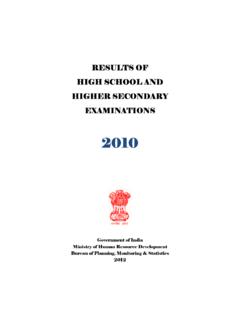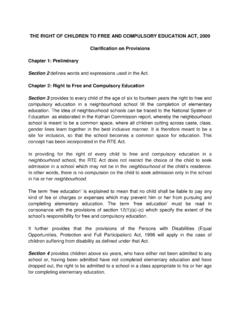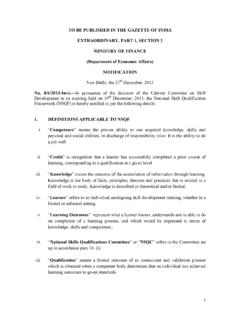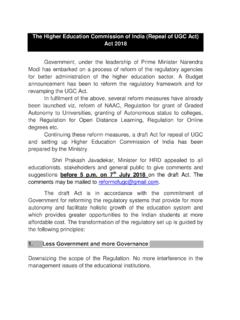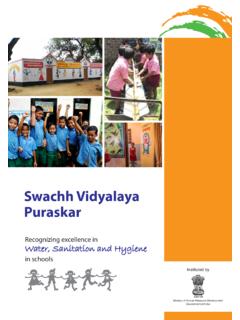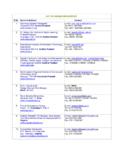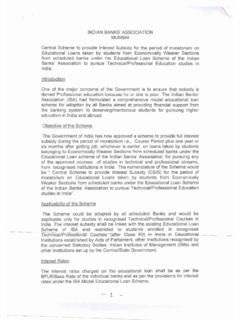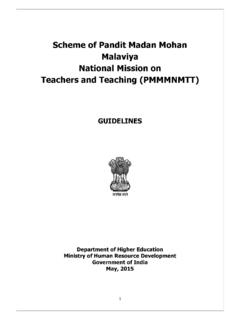Transcription of India writes in many languages and speaks in many more …
1 India writes in many languages and speaks in many more voices. And yet, communication has never broken down in this sub-continent. With about of the world's land surface and a total of 16% of the world's population ( India : A Country Study by James Heitzman and Robert L. Worden eds. Federal Research Division; 1995), India houses according to one estimate, 1,652 mother-tongues including 103 foreign mother tongues (Census 1961 & Nigam 1972: p. xv). Writing came to India much earlier than many other civilizations from the days of the Indus Valley Civilization, by over four thousand years ago, and the space has also witnessed emergence of some of the great writing systems like the Br hm and the Kharosth dating back to roughly 500 Today, India is a space with perhaps the largest base of books, authors and publication houses with about at least 70,000 new titles published every year, enjoyed by over 600 million readers of books in India .
2 Read on to know more about Indian Indian Linguistic and Writing Indus Valley Brahmi Kharosthi Writing States and Linguistic language Families of Indo-Aryan Dravidian Austric Tibeto-Burman languages and Index1. The Indian Linguistic SpaceThe earliest form of speech in India were reflected in the texts such as Rig-Veda, the Brahmanas, and the Upanishads - the oldest preserved treatises from which the Indian "literary" traditions of verse have sprung. The earliest works were composed to be sung or recited, and were orally transmitted for many generations before being written down. The oldest among them are the thousand-odd hymns of the Rig-vedas dating back to two millenium , composed in what is called the Vedic Sanskrit. The Vedas, which derived from the root vid - "to know", tried capturing knowledge that came from the quest for the Indian literary tradition demonstrated that early Indian creative writers interacted very closely with critical thinkers, and a very rich interpretive tradition developed just as they excelled in literary creativity in a number of genres beginning from poetry and in its epic form to story-telling as well as to the dramas.
3 While a lot of these early texts dabbled with the idea of the sacred , even the most revered texts like the Vedas demonstrated that there were streaks of both in its body. The early literary theoreticians could identify different sentiments being reflected in these writings, which have been trend-setters in world literature in many Indian linguistic space, as it exists today in truncated form in the South Asian sub-continent after its independence in 1947, has been a new geo-political identity. But India has, in all ages, been a concept more true on the mental map than being a physical reality. At the same time, she has also contributed to numerous ideas that form the basis of modern-day knowledge-based society. 2. Mother-Tongues and LanguagesThere are different theories about how many of these mother-tongues qualify to be described as independent languages .
4 Even Sir George Grierson's twelve-volume Linguistic Survey of India (1903-1923) material for which was collected in the last decade of the 19th century, had identified 179 languages and 544 dialects. One of the early Census reports also showed 188 languages and 49 dialects (1921 census).Out of these mother-tongues, 184 (Census 1991) or at least, 112 (Census 1981 figure) had more than 10,000 speakers. There are other estimates that would put the number higher or lower; For instance, the encyclopaedic People of India series of the Anthropological Survey of India , identified 75 "major languages " out of a total of 325 languages used in Indian households. Ethnologue, too reports India as a home for 398 languages , including 387 living and 11 extinct languages . Most importantly, as early as in the1990s, India was reported to have 32 languages with one million or more speakers.
5 The People of India also reports that there are 25 writing systems in India that are in active use as in 1990s. The results of a 1989-survey titled The Written languages of The World : A Survey of the Degree and Modes of Use (2. India , Book 1, Constitutional languages , Book 2, Non-Constitutional languages ) conducted by , , , (Office of the Registrar General, India , Laval University Press) showed that there are at least 50 Indian languages in which writing and publishing are done in substantial The Writing The Indus Valley ScriptThe Indus Valley Script was a product of the now well-known Indus Valley Civilization. The greater Indus region was home to the largest of the four ancient urban civilizations, others being the Egyptian, Mesopotamian, and Chinese civilizations. Most of its ruins remain to be fully excavated and studied, as nothing was known about this civilization until 1920s.
6 What is more, the ancient Indus script has not yet been deciphered although there have been many claims and counter-claims. The samples of Indus Valley Script are huge - about 1000 settlements spreading all of modern Pakistan, and parts of India and Afghanistan. But the main corpus of writing include 2,000 inscribed brief seals and tablets of 6 to 26 symbols each which are still undeciphered. There are several competing theories about the language which the Indus script represents. But it appears that there was an equally strong multi-racial and multi-lingual existence then which has further contributed to the difficulties in The Br hm ScriptThere were many other systems of writing but none had as far reaching effect as the Br hm script. George B hler in his 1895-98 work, entitled Sitzungsberichte der kaiserlichen Akademie der Wissenschaften, Wien, (Philologisch-historische Classe 132, , 1895.)
7 2nd revised ed.: Strassburg: Karl J. Tr bner, 1898; Rept Varanasi, 1963) had conjectured that one of the earliest writing systems in India , the Br hm script had perhaps originated as far back as in the 8th Century Some trace Br hm to Indus Script. But the Harappan ended by 1900 BC & the first Brahmi and Kharoshthi inscriptions date to roughly 500 BC. It is difficult to explain the gap. Brahmi is a "syllabic alphabet", meaning that each character carries a consonant plus a neutral vowel "a", like Old Persian, but unlike it, Br hm uses the same consonant with extra strokes to combine with different vowels. B hler argued for a Phoenician script, although some other specialists like Diringer thought of an Aramaic origin of Br hm . There are controversies as to whether one should accept what the studies of Fussman, von Hin ber, and Falk concluded, namely that this script was only datable from the time of Ashoka, or whether as many Indian epigraphists argued, its dates could be pushed back much The Kharosth ScriptThe Kharosthi Script was almost contemporarily with the Br hm , and it appeared by 3rd c.
8 BC in northern Pakistan and east Afghanistan. Some examples of Kharosthi are also found in India . Kharosthi was used primarily for the Prakrit dialect of Gandhari. In structure & sequence, Kharosthi and Br hm are similar, except that Br hm had different signs for different initial vowels, but it used the same marks that change vowels in Consonant-Vowel combinations, and while Br hm had long and short vowel signs, Kharosthi had only one. Kharosthi Script fell out of use by the 3rd or 4th century Modern-day Writing SystemsAlthough Indian writing systems number at least 25 in a recent survey, the major scripts are 14, out of which 12 originated from the Br hm . Like the Greek alphabet, it had many local variants and gave rise to many Asian scripts - Burmese, Thai, Tibetan, etc. Emperor Asoka inscribed his laws as well as Lord Buddha s teachings onto columns in Brahmi.
9 [MORE TO FOLLOW]4. Indian States and MultilingualismIndia houses about billion people with a population growth rate of a year. As per Census 2001 statistics, India is administratively organized into 35 entities, each as big as many independent nations. There are 28 States and seven Union Territories, broadly set up on the linguistic principle. Currently, India has 51 Cities, 384 Urban Agglomerates and 5,161 Towns (2,843 in 1951) in India , with about of its total population. Howver, most Indians still live in rural areas and in small towns with different linguistic practices, and with scanty knowledge of Indian state also happens to be pluri-cultural, besides showing a great degree of multilingualism as the following table would show:SetSTATESMAJOR LANGUAGEOTHER languages WITH SIGNIFICANT POPULATION ( )Tamil, KannadaPunjabPunjabi ( )Hindi, UrduGujaratGujarati ( )Hindi, SindhiHaryanaHindi ( )Punjabi, ( )Urdu, PunjabiRajasthanHindi ( )Bhili, ( )Punjabi, KinnauriTamil NaduTamil ( )Telugu, KannadaWest BengalBangla ( )Hindi, ( )Urdu, ( )Bhili, GondiBiharHindi ( )Urdu, SantaliOrissaOriya ( )Hindi, TeluguMizoramLushai ( )Bangla, LakherMaharashtraMarathi ( )Hindi, ( )Marathi, KannadaMeghalayaKhasi ( )Garo, BanglaTripuraBangla ( )Tripuri, HindiKarnatakaKannada ( )Urdu, ( )Bhotia, LepchaManipurManipuri ( )Thadou, TangkhulAssamAssamese ( )Bangla, Nissi ( )Nepali,BanglaNagalandAo ( )Sema, Konyak5.
10 The Linguistic RecognitionAs of today, the Indian constitution recognizes 22 major languages of India in what is known as the 8th Schedule of the Constitution. They also happen to be the major literary languages in India , with a considerable volume of writing in them. They include, besides Sanskrit, the following 21 modern Indian languages : Assamese, Bangla, Bodo, Dogri, Gujarati, Hindi, Kashmiri, Kannada, Konkani, Maithili, Malayalam, Manipuri, Marathi, Nepali, Oriya, Punjabi, Tamil, Telugu, Santali, Sindhi, and Urdu. Originally, only 14 languages were included in the 8th Schedule of the Indian constitution. Bodo, Dogri, Konkani, Maithili, Manipuri, Nepali, Santali and Sindhi were recognized first Prime Minister of India , Pt. Jawaharlal Nehru had made this comment about the recognition of languages : The makers of our Constitution were wise in laying down that all the 13 or 14 languages were to be national languages .


